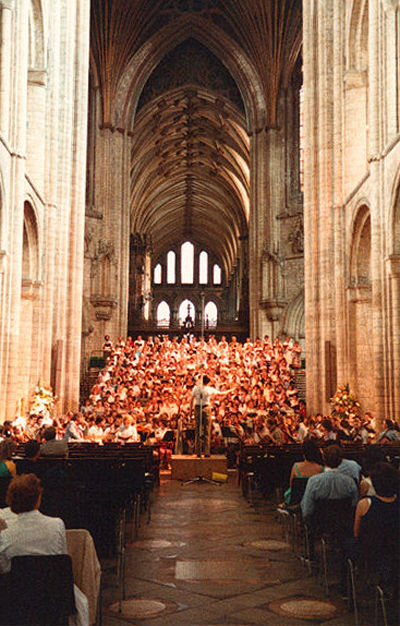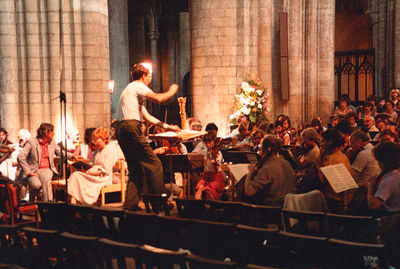| Columns Retired Columns & Blogs |
Stereophile's Test CD 2 Track 13
Track Information, Track 13
Footnote 6: At the time of writing Audio Editor of Gramophone magazine.
[13] Edward Elgar: The Dream of Gerontius, Part 1 (conclusion) (ADD) 7:07
Stephen Roberts (bass), Oundle & District Choral Society, St. Ives Choral Society, St. Neots Choral Society, Huntingdonshire Philharmonic, conducted by Christopher Brown, with Arthur Willis at the organ of Ely Cathedral
Recording Venue: Ely Cathedral, Ely, England
Recording Date: July 7, 1984
Recording Engineers: John Atkinson, Ivor Humphreys (footnote 6)
Microphone: Calrec (AMS) SoundField Mk.III, set to coincident figure-8 pattern at 90 degrees
Recorder: ReVox A77 Mk.IV ¼" open-reel recorder at 15ips (NAB EQ) with dbx II noise reduction
Tape: TDK GX
Transfer to digital: Manley Analogue to Digital Converter, Aiwa HD-S1 DAT, ReVox PR-99 open-reel recorder, dbx 224 noise-reduction unit, AudioQuest Lapis balanced interconnects
Digital Transfer Engineer: John Atkinson
The Calrec Soundfield microphone, a single-point, multi-capsule design originally developed to make Ambisonic recordings, is supplied with a sophisticated control center that, in addition to Ambisonic pickup, allows the user to select many different coincident stereo patterns. For this recording John Atkinson used the control center to synthesize a pair of figure-8 microphones pointing left and right with an angle of 90 degrees between them. This gives an extremely accurate recreation of the original soundfield, but as such a pair of microphones picks up all the sounds to their rear as well as to their front, it's hard for the engineer to strike exactly the right balance between the direct sound of the instruments and the echoes of that sound from the hall's walls, ceiling, and floor: the "reverberation." Small forward and backward movements in microphone positioning also yield large changes in the recording's soundstage perspective.

The audience's view of Gerontius in Ely Cathedral: the SoundField mike is on the tall stand above the conductor's head; the orchestra overflows into the arches each side of the nave.
Because of restrictions imposed by the Cathedral staff, who were worried about the microphone falling on members of the audience, the only place it was possible to place the SoundField mike was on a high stand about 12' above the conductor's head (see photo). This means that the image of the solo bass, who portrays the Priest, is set far left, in theory beyond the outside edge of the loudspeaker. The large orchestra, on the floor, is relatively much closer to the microphone than the 200-strong choir (who were on risers), which means that the strings, in particular, sound somewhat dry. The orchestral image is also very wide, with the tympani, double-basses, and harp at the edges of the soundstage. Note that what Gordon Holt calls the "brassy blattiness" of the trombones and trumpets is captured intact by the relatively distant miking. It's rare to hear these instruments this "brassy" and "blatty."
Overall, however, a tremendous sense of space has been captured by the single-point technique, and the choir should sound distinct but set well back in the Cathedral's stone-faced acoustic. The organ pipes are positioned on the middle left, in the vast altar space behind the choir. Elgar uses the instrument's pedals to underpin the work's tonal foundations at strategic points; sitting where JA was, beneath the choir risers, he remembers the live sound of the 16' and 32' bass pipes shaking him to the core at the end of the work's first part.

Gerontius in rehearsal, with flautist Peter Walker of Quad just visible at the right of the photograph.
As indeed this music, part both of the greatest work in the English choral tradition and of one of the greatest Roman Catholic pieces, should. Elgar wrote Gerontius, based on a poem by Cardinal Newman concerning the travails the soul of an ordinary man endures after death on the way to judgment and Purgatory, in the closing days of the Victorian era. Both the music and the spirit of the work have strong ties to Wagner's Parsifal, while the "Go forth upon your journey Christian soul" theme heard in this extract is based on one Elgar had composed with General Gordon of Khartoum in mind—Gordon had been deeply moved by Newman's poem—for use in a symphony but which he then rejected. "This is the best of me...this, if anything of mine, is worth your memory," Elgar quoted from Ruskin on the work's manuscript score. Which makes it all the more surprising that the first performance, conducted by an unprepared Hans Richter at the Birmingham Triennial Music Festival in October 1900, was a complete disaster. It did not take many years, however, for the work's quality to shine through, and it is now widely regarded as being the work most closely identified with the greatest English composer.
Footnote 6: At the time of writing Audio Editor of Gramophone magazine.
- Log in or register to post comments




































